Palio di Asti
The Palio di Asti is a medieval festival organized in Italian city of Asti on the third Sunday in September. The most important part of the festival is famous bareback horse race.
Asti is a city of 75,000 people located in the Piedmont region of northwestern Italy. The city is just 55 kilometres east of Turin. It is a city of amazing architecture. Citizens of Asti are proud of numerous local dishes like for example “bönet”, kind of chocolate pudding, and “bagna caôda”, a sauce with anchovies, garlic and oil.
What exactly is Palio? The word palio comes from the Latin pallium. Pallium belonged to the Ancient Roman fashion. It was a rectangular piece of cloth worn as a cloak by the people of that time. What is the relation between palio and this horse race? The palio was once the piece of cloth that was put at the finishing post and awarded to the winner of the race. Nowadays word palio includes the whole event.
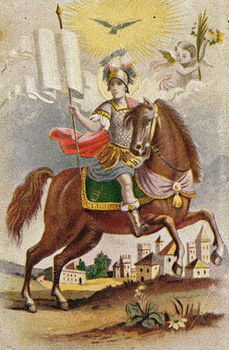 Saint Secunudus (San Secondo)
Saint Secunudus (San Secondo)
In its beginnings the race was organized on the feast day of Saint Secunudus (San Secondo) who is the patron saint of Asti. Until the 15th century it was on the 30th of March. Today people of Asti honour this saint on the first Tuesday in May.
The first document mentioning the Palio was the one from 1275. That year Guglielmo Ventura (about 1250 – about 1325) wrote that Asti, "sicut fieri solet Ast, in festo Beati Secundi" (as is usual in Asti, during the Feast of San Secondo), ran a Palio under the walls of enemy city of Alba with intention to ridicule its citizens, in the meantime destroying the surrounding vineyards.
It is believed that the Palio is even older. It has its origin sometime in years after 1000. From the end of 13th century until the mid 14th century the race was held on a circular track or "circulum" around what are now Piazza Alfieri and Piazza Libertà.
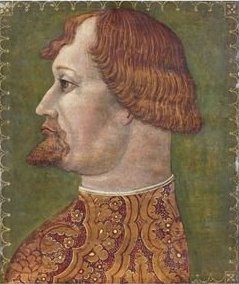 Gian Galeazzo Visconti (1351-1402)
Gian Galeazzo Visconti (1351-1402)
In 1382 the city lord Gian Galeazzo Visconti (1351-1402) built a new citadel on the ciriculum. This mean a new track for the Palio. The new course started at the cippo del pilone, 2.5 kilometres out of town, passed through the Porta San Pietro, along the bridge on Rio Valmanera, along the Contrada Maestra (now the Corso Alfieri, the main street in Asti), ending at the Palazzo Gabuti di Bestagno, the current Palazzo Ottolenghi.
From the 15th century both the day of the Palio and the Feast of San Secondo were moved to the second Thursday after Easter. At the beginning of the 19th century the race was held three days later, on the second Sunday after Easter.
Move moving of the dates happened in 1818. From that year San Secondo feast and the Palio were organized on the first Tuesday in May.
Quite big change happened in 1861 the race track was not straight anymore. The track or "the Campo del Palio" (Palio Field) was at the new Market Square.
Yet another change happened two years later. The event lost its religious component.
The Palio di Asti was not held in the 1870s. The event also had a 30 years break in the 20th century.
Fascist era in Italy bring changes again. In 1929 the race was held on a 1300 meters long straight race track on Corso Dante.
In 1936 Benito Mussolini changed the Palio to a certame cavalleresco (chivalrous contest).
On the 3rd of May, 1936, during Second Italo-Abyssinian War, group of Italian soldiers held rather unusual palio race on the bank of Lake Ashenge (Ashangi) in Ethiopia. The participants had been riding on donkeys.
In 1967 the true Palio was born again. The time of race was moved to September when it coincided with the wine exhibition called Douja d'Or. This time was also chosen as it follows the Festa delle sagre astigiane - Asti's Festival of Festivals. The 1861 race track in the Piazza Campo del Palio was used in the Palio of 1967. More than 100,000 people watched the race.
Since 1988 the event is held on the Piazza Alfieri. It has a triangular shape and is located in the centre of city. The day of the race starts with a blessing of horses and jockeys.
Next on the Piazza San Secondo there is an exhibition of flag throwers. At noon the registration of horses and jockeys is done in the town hall on the Piazza San Secondo.
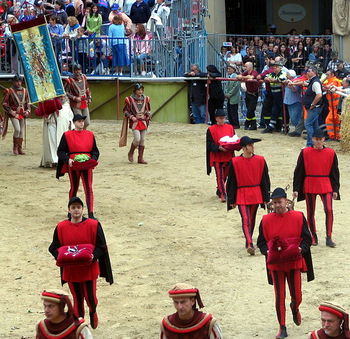 Big parade with 1200 people
Big parade with 1200 people
At 2.15 pm there is a big parade with 1200 people wearing medieval costumes. The parade starts on the Piazza Cattedrale and ends on the Piazza Alfieri. The complete route of the parade is Piazza Cattedrale - Via Caracciolo - Piazza Cairoli - Corso Alfieri - Via Gobetti - Piazza San Secondo - Via Garibaldi - Via Gardini - Piazza Alfieri.
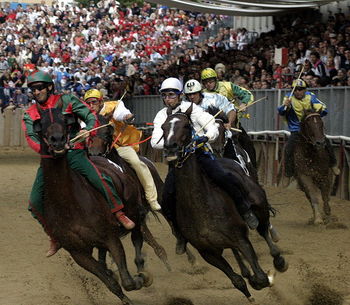 Palio di Asti - the race where riders ride with no saddle
Palio di Asti - the race where riders ride with no saddle
The start of the race is at 4.00 pm. Riders compete bareback meaning they ride with no saddle. There are three qualifying races. Seven horses participate in each race. Three best horses in each of qualifying races progress to the final race. Between qualifications and the finals there is a flag-throwers show. The final race starts at 6.00 pm.
The winner receives the crimson banner with the coat of arms of the city and the image of San Secondo, the Patron Saint of Asti.
In the days before the race there are numerous other events like the Palio degli Sbandieratori, the flea market and the trials of owner-jockeys on the field.
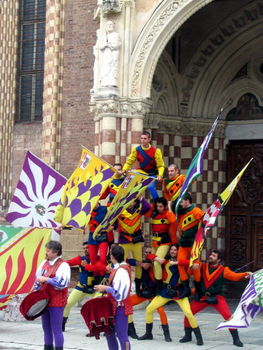 Palio degli Sbandieratori
Palio degli Sbandieratori
The Palio degli Sbandieratori is a competition of groups of flag-throwers. Groups represent different city quarters.